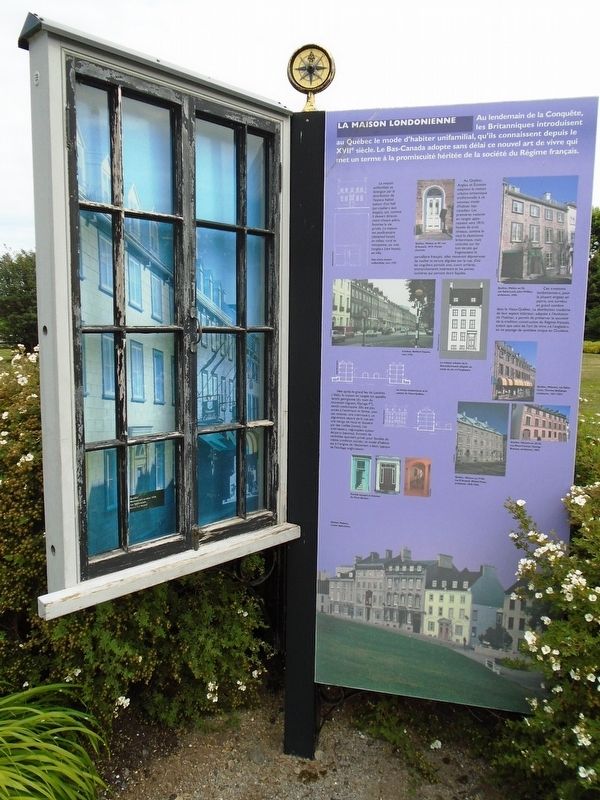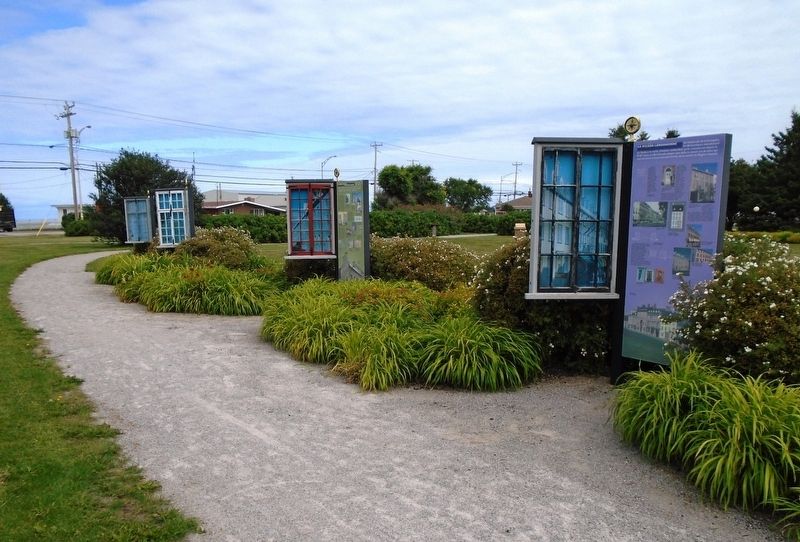La maison Londonienne / The London house
Au lendemain de la Conquête, les Britanniques introduisent au Québec le mode d'habiter unifamilial, qu'ils connaissent depuis le XVIIe siècle. Le Bas-Canada adopte sans délai ce nouvel art de vivre qui met un terme à la promiscuité héritée de la société du Régime français.
La maison unifamiliale se distingue par la distribution de l'espace habité autour d'un hall (un « palier » aux étages), qui, comme il dessert directement chaque pièce, favorise la vie privée. La maison est pavillonnaire (detached house) en milieu rural et mitoyenne, ou « en rangée » (row house), en ville.
Au Québec, Anglais et Écossais adaptent la maison urbaine britannique traditionnelle à ce nouveau mode d'habiter bas-canadien. Les premières maisons en rangée apparaissent vers 1815, hautes de trois niveaux, comme le veut le classicisme britannique, mais coincées sur les lots étroits qui fragmentent le parcellaire français; elles resteront dépourvues de ruelles et seront alignées sur la rue, d'où les singuliers portails avec cours arrières, emmarchements intérieurs et les portes cochères qui percent leurs façades.
Ces
« maisons londoniennes », pour la plupart érigées en pierre, ont survécu en grand nombre dans le Vieux-Québec. La distribution moderne de leur espace intérieur, adaptée à l'évolution de l'habiter , a permis de préserver le souvenir de la tradition constructive du Régime français, autant que celui de l'art de vivre « à l'anglaise », en un paysage de synthèse unique en Occident.Née après le grand feu de Londres (1666), la maison en rangée est appelée tantôt georgienne (du nom du souverain régnant, George 1er), tantôt londonienne. Elle est peu ornée à l'extérieur et forme, avec ses voisines, une « terrasse », un alignement séparé de la rue par une marge de recul et desservi par des ruelles (mews). Les « terrasse », regroupées autour de parcs (squares), forment de véritables quartiers privés pour familles de même condition sociale; ce mode d'habiter est à l'origine de l'étalement urbain, typique de l'héritage anglo-saxon.
[Légendes des illustrations, en haut à gauche, dans le sens des aiguilles d'une montre, lisez]
• Plan d'une maison unifamiliale, vers 1775.
• Québec. Maison au 89, rue D'Auteuil, 1819. Portail d'entrée.
• Québec. Maison au 56, rue Saint-Louis. John Phillips, architecte, 1830.
• La maison urbaine de la Nouvelle-France adaptée au mode de vie «à l'anglaise».
• Québec. Maisons, rue Saint-Louis. Thomas
• Québec. Maisons au 20-22 rue Mont-Carmel. George Browne, architecte, 1832.
• Québec. Maisons au 77-83, rue D'Auteuil. Michel Patry, architecte, 1845-1846.
• Portails typiques et intérieur du Vieux-Québec.
• La maison londonienne et la maison du Vieux-Québec.
• Londres. Bedford Square, vers 1775.
[La légende de la grande photo du bas se lit]
Québec, Maisons,
avenue Saint-Denis.
[La légende de la photo d'arrière-plan de la fenêtre se lit]
Québec
Maison des années 1830,
rue Saint-Louis
In the aftermath of the Conquest, the British introduced to Quebec the concept of single-family living, which they had known since the 17th century. Lower Canada adopted without delay this new style of living which put an end to the promiscuity inherited from French Regime society.
The single-family home is distinguished by the distribution of living space around a hall (a "landing" on each floor), which, as it directly serves each room, promotes privacy. The house was a detached house in rural areas, and a terraced "row house" in town.
In Quebec, the English and Scottish adapted the traditional British urban house to this new way of Lower Canada living. The first row houses appeared around 1815, three levels high based on British
These "London houses," mostly built of stone, have survived in large numbers in Old Quebec and provide a synthesis of the French Regime's construction tradition with the art of English living. The modern layout of their interior spaces, adapted to evolving tastes, contribute to this unique built Lower Canada landscape.
Born after the Great Fire of London (1666), the townhouse was sometimes called Georgian (after the reigning sovereign, George I), sometimes London. It was largely unadorned on the outside and formed with its neighbors a "terrace," an alignment separated from the street by a setback, and served by alleys (mews). The "terraces," grouped around parks (squares), formed true private districts for families of the same social class. This mode of living formed the origin of urban sprawl, typical of Anglo-Saxon heritage.
[Illustration captions, clockwise from top left, read]
• Quebec. House at 89, rue D'Auteuil, 1819. Entrance gate.
• Quebec. House at 56, rue Saint-Louis. John Phillips, architect, 1830.
• The New France urban house adapted to the English lifestyle.
• Quebec. Houses, rue St. Louis. Thomas Baillairgé, architect, 1831-1833.
• Quebec. Houses at 20-22 Mont-Carmel Street. George Browne, architect, 1832.
• Quebec. Houses at 77-83, rue d'Auteuil. Michel Patry, architect, 1845-1846.
• Typical Old Quebec portals and interior.
• The London house and the Old Quebec House.
• London. Bedford Square, circa 1775.
[Large bottom photo caption reads]
[Window background photo caption reads]
• Single-family house plan, circa 1775.
Quebec, Houses,
Saint-Denis Avenue.
Quebec
House of the 1830s,
St. Louis Street
Topics. This historical marker is listed in this topic list: Architecture. A significant historical year for this entry is 1830.
Location. 48° 29.064′ N, 68° 29.752′ W. Marker is in Rimouski, Québec, in Rimouski-Neigette. Marker is on boulevard du Rivage (Québec Route 132), on the right when traveling north. Marker is on the grounds of Maison Lamontagne House Historic Site. Touch for map. Marker is at or near this postal address: 707 boulevard du Rivage, Rimouski QC G5L 7L3, Canada. Touch for directions.
Other nearby markers. At least 8 other markers are within walking distance of this marker. Villas et villégiature / Villas and Resorts (here, next to this marker); La maison urbaine en Nouvelle-France / The Urban House in New France (here, next to this marker); La maison rurale du Bas-Canada / The Rural House of Lower Canada (a few steps from this marker); La maison rurale en Nouvelle-France / The Rural House in New France (a few steps from this marker); Maisons des faubourgs / Suburban Houses (a few steps from this marker); L'habitat ouvrier urbain / Urban Worker Housing (a few steps from this marker); Les maisons de notables / Noteworthy Houses (a few steps from this marker); Les maisons de colonisation / Settlement Houses (within shouting distance of this marker). Touch for a list and map of all markers in Rimouski.
Also see . . .
1. The Architecture of Old Quebec, or The History of a Palimpsest (Noppen and Morisett). (Submitted on April 20, 2019, by William Fischer, Jr. of Scranton, Pennsylvania.)
2. Maison Lamontagne House Historic Site. (Submitted on April 21, 2019, by William Fischer, Jr. of Scranton, Pennsylvania.)
Credits. This page was last revised on January 20, 2020. It was originally submitted on April 13, 2019, by William Fischer, Jr. of Scranton, Pennsylvania. This page has been viewed 171 times since then and 19 times this year. Photos: 1, 2. submitted on April 21, 2019, by William Fischer, Jr. of Scranton, Pennsylvania.

